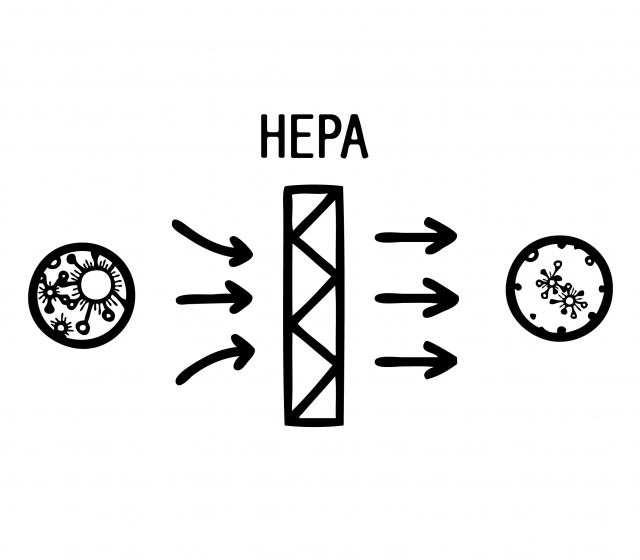How do HEPA air purifiers compare to filterless ionic air purifiers?
Researching which air purifier to buy can be a tedious task. There are multiple types, a wide variety of prices and consideration of the space you will be using it in. We will give you some information about two of the most popular air filters available today: HEPA filters and ionic air purifiers.
How It Works

High Efficiency Particulate Air (HEPA) filter works by using a fan to force air through a fine mesh that traps harmful particles such as pollen, pet dander, dust mites and tobacco smoke. Filters meeting the HEPA standard must satisfy certain levels of efficiency. Common standards require that a HEPA air filter must remove—from the air that passes through—at least 99.97% of particles whose diameter is greater than or equal to 0.3 μm. A HEPA filter actually traps airborne contaminants, but can lose any effectiveness once it becomes clogged with debris. Once saturated, the filter can release pollutants trapped on the filter surface back into the air. A HEPA filter also has a greater footprint than filterless air purifiers, since the HEPA filter needs to be replaced approximately every 6-8 months.

A filterless ionic air purifier operates by sending out electrically charged ions into the air that bond with harmful impurities. Once a bond is made, these particles become too heavy to stay in the air. This results in the contaminants falling to the floor or grounded object (depending on the device and placement), where they are attracted to the positively charged collection plate and later cleaned off by the owner. Products that include a collection plate or placed in a neutral location are better at avoiding the chance that particles can be kicked back up into the air when people walk through the room. For example, the Wein® Products Vortex Ionic Air Purifier ion emitter stimulates airflow by discharging ions in a rapid, spiral vortex motion- actually drawing airborne pollutants to the device, instead of waiting for them to randomly pass near the unit. The “on” and “off” feature of the device is beneficial because it regulates the high ion output by intermittently discharging ions. Negatively charged ions are beneficial to the environment because they attract the positive ions found in dust, pollen, bacteria, cigarette smoke and mold spores--and pull these microscopic hazards to the earth using electrostatic forces. This ionic air purifier can filter particles as small as 0.01 μm, including certain viruses, bacteria and fumes.
How big is the space you’re purifying?
The largest space an air purifier with a HEPA filter can purify is about 1,560 sq. ft. This is fine for most home applications, but for a large business space this may not be sufficient. In comparison, some ionizers can purify an air space up to 3,500 sq. ft.
Other concerns
Noise level is another feature to consider when comparing HEPA air purifiers and ionic air purifiers. HEPA air purifiers are designed to circulate air in the room and remove contaminants, dust and allergens by trapping them in filters. Unlike ionic purifiers, HEPA purifiers always use a fan – it’s not possible for a product to work without one. Ionic air purifiers are usually fanless, therefore silent.
Do you want a portable air purifier or one that is stationary? Since ionic purifiers are filterless and fanless they can be much smaller than their counterpart, hence more portable! This allows for the possibility to have a personal air purifier like the Wein® Products Air Supply® Rechargeable that you wear to clean pollutants from the air wherever you go, like doctor appointments, driving, in the office or when traveling.
What about ozone emission safety?
You may have heard about the danger of ozone air purifiers, which use ozone to clean the air. Due to the serious health effects that ozone can have on people, federal agencies have established the following set of health standards for what are considered safe levels of exposure for ozone:
- Healthy Amount = 0 to 0.05 ppm
- Moderate Concern = 51 to 100 ppm
- Hazardous Amount = 100+ ppm
With such standards in place, the Food and Drug Administration (FDA) now requires that ozone output for indoor medical devices is no more than 0.05 parts per million. Any higher and the product would be considered unsafe for continuous home use. Ionic air purifiers, like Wein® Products air purifiers, are ozone-safe and certified by OSHA standards to produce ozone emission concentrations less than 0.050 ppm. Ionic air purifiers should not be confused with ozone air purifiers. Unlike ionizers, ozone generators produce a lot of ozone molecules in the air and don’t internally collect contaminant particles. The idea is for ozone to bond with airborne particulates which then fall from the air. They are commonly used to quickly remove airborne contaminants and odors, however the same thing that makes them efficient is what makes them harmful to humans because of the high ozone output.
